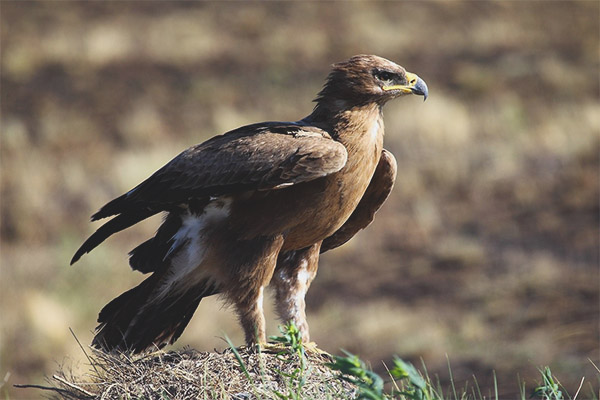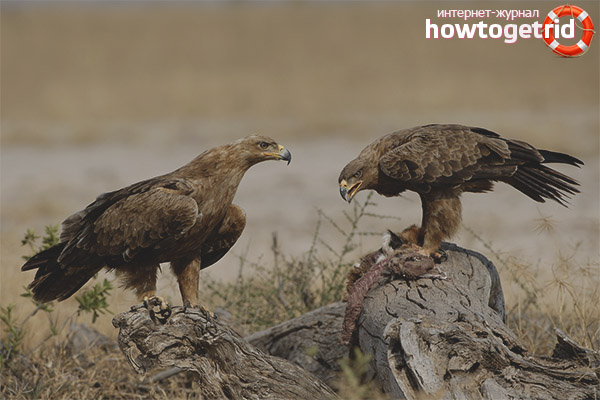The content of the article
The steppe eagle is a rather rare species of birds of prey belonging to the family of hawks. Currently, they are included in the Red Book, being a bird on the verge of extinction. By the way, about thirty years ago, steppe eagles settled large territories in the north of Eurasia, being a numerous species.
Once the stone eagles, who lived in India and Africa, were mistakenly called steppe eagles due to external similarities. Only thanks to DNA analyzes it was possible to divide these two species into separate, but, unfortunately, inscribed in the Red Book.
The appearance of the steppe eagle
The bird is a predator with large sizes: the male's body is on average 73 cm long, and the females are about 80 cm.The weight of a male can reach 4.5 kg, while females are usually more massive, their weight is often equal to 5.4 kg. In addition to body size, there are no other differences between the sexes, therefore, it will be possible, perhaps, to distinguish the male from the female only in the bird pair, which nests and incubates.
The wings of these birds are elongated and rather wide, the length of the wings of the male reaches 62 cm, and the female 65 cm. Those people who could observe the steppe eagle during the flight were certainly impressed with the majesty of this “king” of the heavens. The total wingspan of the bird is about 220 cm. The wingspan of more than only the golden eagle. The steppe eagle proudly and stately floats in a straight plane, its wings are located on a parallel line to the ground. Sometimes the tips of the wings down to the bottom.
The tail of the bird is slightly roundish, short. The extremities are covered with plumage completely, up to the fingers, and this can be seen in the photographs of the eagle. Bird fingers have a yellowish tint, claws tenacious, strong, black. The bird's beak is massive, specifically curved, grayish in color, rather strong in appearance. Cereblasus is saturated yellow, along the edge of the mouth there is a yellowish rim.The eyes of a predator are large, the color is brown and nut.
In the first year after their birth, these birds have brown-ocher plumage, in which brown-yellowish mottles are visible. Steering tail on the tail is painted in dark brown with a yellow border.
When it reaches the age of four years, this bird acquires a different, more monotonous brown-dark color. A number of birds at the same time can be seen on the back of his head a small reddish speck. Steering tail covered with gray stripes located across the tail.
Habitat Lifestyle
The eagles go to wintering in India, Africa and the Arabian n / c. Most often, the steppe representatives make the flight alone, in more rare cases they form small groups - no more than 3 individuals.The stops necessary for rest, these birds also make without unnecessary accumulations, in places of feeding you can usually see no more than five birds.
In order to exist normally, the steppe eagle needs free spaces, an open area. Often it can be desert areas, steppes, plains that are untouched by man, dry landscapes, studded with hills, where there are rocks.
Along with other representatives of the hawk, the steppe eagle prefers daytime living - it is easier for him to observe the surroundings, trying to find prey.
Diet and hunting features
The main diet of a predator consists of small or medium-sized rodents, most of them are ground squirrels, in some cases - hares. Often, the steppe eagle manages to get small chicks, eggs, or young birds, and the predator will not be squeamish about reptiles of small size.
The steppe eagle is not averse to eating carrion, especially if there is a sharp drop in the number of hares or gophers. It was often possible to see how, near the carcass of a fallen animal, without internal conflicts, up to 10 predators were feeding at the same time.
The steppe eagle uses for hunting the same methods that are inherent in other hawks. Having a magnificent vision with a wide viewing angle, the bird can find small animals from a great height. When the predator spotted the prey, it collapses like a stone, exposing strong fingers decorated with sharp claws in front.
In addition, the steppe eagle can hunt from an ambush, and this gives its results in situations where the bird can find a large colony of gophers at once. In this case, the eagle shows tremendous patience, waiting for a small stone or a hill. When the victim comes out of its mink, the eagle immediately catches it. By the way, these birds can run pretty fast.
Each representative of feathered predators, which have a rather narrow diet, breeding and feeding periods are inextricably linked with themselves. For example, the incubation and hatching of chicks at the polar owl is associated with the multiplicity of lemmings in these regions. In the same way, the steppe eagles stop their reproduction, if it turns out that there are not enough gophers to breed chicks. During such periods, these birds stop nesting,and begin to lead a nomadic lifestyle, which is aimed only at finding food.
Breeding periods
Like other birds from the family of hawks, a rather strong pair is formed in the steppe eagles, in which responsibilities between the male and the female are clearly and unreservedly distributed. The male is instructed to protect the family and get food, and the female takes care of the offspring by incubating and warming the chicks.
As soon as the snow melts, these birds return to their own nesting place. By that time, the rodents are already beginning to emerge from hibernation. The predators return to the southern nesting places approximately in the second half of March, with regards to the north, then the steppe eagles begin to appear closer to the beginning of April.
The total nesting area is determined by how well the feeding base is developed in a particular area. If the number of gophers is high, then the nests can be literally one kilometer apart from each other.
Nesting features
Steppe eagles are not distinguished by their particular pretentiousness and fastidiousness when choosing a site for building nests.The main condition is the ability to fly up to him from above without hindrance. They can be content with ledges of rocks, thickets of small bushes, and also trees which stand separately. In addition, power lines, stacks of dry grass, ruins of buildings, heaps of metal can be selected for building a nest. Sometimes predators build a nest right on the surface of the earth, where there are small elevations or hummocks made of sand.
The size of the nest and its shape will be fully determined by the type of area chosen. If this is the surface of the earth, then the nest will be an ordinary structure made of plants and randomly scattered branches. If nesting will be built at a height, then it will be built more thoroughly. Its diameter can be up to one meter. In addition to grass tufts and tree branches, various other materials can be used: fragments of animal skins, manure, pieces of paper and cardboard, bones, and even metal wire.
Nests are usually quite strong, so they can be used annually. Upon arrival, the steppe eagle usually updates the structure. And it is at this very moment that rather complex traditional rituals associated with marriage games are performed: joint long flights, entertainment and games in the air.All this precedes the mating of birds.
Procreation
The female bird usually lays up to two white eggs, which are covered with chaotic specks and brownish specks. Hatching of offspring begins as soon as the first egg appears, and takes about one and a half months.
At first, the chick hatches from the egg that first appeared, and the last chick from the brood, which is of different ages, very often dies from lack of food. The little body of the eagles, which have just been born, is strewn with white fuzz, then the plumage takes on a slightly grayish tint. The male of the steppe eagle delivers to the nest with the female and the offspring of gophers, and the eagle warms the nestlings at night. If the day comes the heat and heat, then the parents open their wings wide to protect them with a brood shadow.
Then the chicks are in the nesting place for two months, and by the age of 80 days they become completely independent. By this time, they are ready to safely make long flights. Under natural conditions, the life span of a predator is much less than in an aviary - up to 48 years.
The current state of these birds
A serious and catastrophic decrease in the population of the steppe eagles is associated with human activity: the reduction in numbers occurred due to the total development of virgin lands, the extermination of small animals and rodents that make up the bird ration, poisons, the abundance of power lines and wires, the use of metal masts as power lines.
As measures for the protection of the population, which were adopted by international organizations, you must specify serious fines for damage to predator clutches and hunting them, a strict taboo on killing gophers, as well as the use of special devices to protect birds on metal power transmission tower masts.
If people do not begin to comply with rather banal requirements, then this can turn into the complete disappearance of a magnificent representative of birds.
Video: Steppe Eagle (Aquila nipalensis)













To send